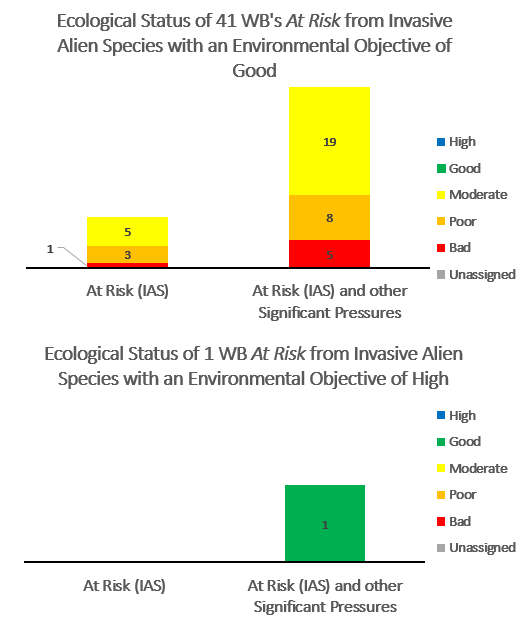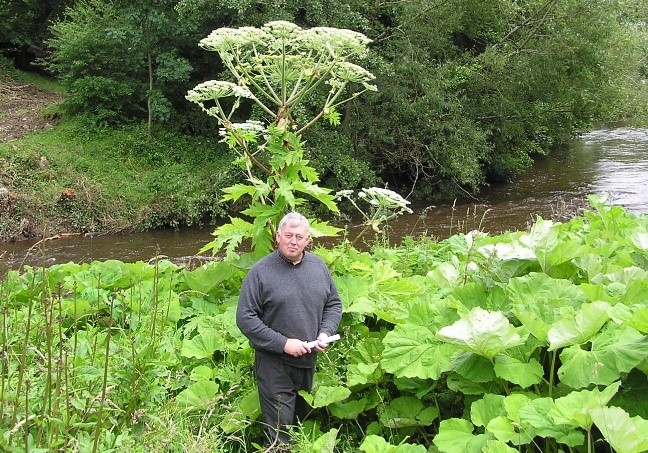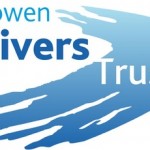The spread of the Invasive species Himalayan Balsam has been…
Significant Pressures: Invasive Species
Invasive species are a significant pressure impacting 42 or 1.8% of the 1,460 At Risk water bodies. This total of 42 is made up of 7 river and 35 lake water bodies.
Invasive species are non-native species introduced outside their natural range that threaten ecosystems, habitats and native species with environmental or socio-economic harm. Currently 37 species have been identified across the EU as a high priority for management, and nine of these occur in Ireland.
The river basin public consultations on significant watermanagement issues in 2015 identified Invasive Aquatic Species (IAS) as a significant issue for water management. For example, two species that pose a threat to aquatic ecosystems when present in riparian zones — Japanese knotweed and Himalayan balsam — have been recorded throughout a significant proportion of the countryside by the National Biodiversity Data Centre.
The impact of invasive species was not assessed in detail because the available information is limited. However, information on their presence at EPA biological monitoring sites and data from the local authorities and IFI were used. EPA monitoring and local knowledge from local authorities and IFI has confirmed the widespread presence of IAS nationally.
The potential impacts of IAS include the alteration of eco-systems
(by causing bank erosion, for example), inhibition of access to water bodies, hindrance of land development and, in some cases, potential human health impacts.
Measures for dealing with IAS will include monitoring, surveillance, early-warning protocols, rapid response, control and bio-security. The Department of Culture, Heritage and the Gaeltacht, and the Heritage Council funds the National Biodiversity Data Centre so it can collate and disseminate surveillance information, including early warnings on the risks and/or discovery of IAS.
There will be a critical role to play in IAS data gathering and management for the new Local Authority Water Catchment Assessment Teams. Local Catchment Assessment guidance developed by the EPA includes the identification of aquatic IAS among the principal components of the assessment methodology and these Assessments will be key datasets in building a national picture of the presence of IAS.
To manage invasive alien species, a catchment-based approach is essential – these species need to be removed in the upper reaches of a catchment first, followed by work downstream so they cannot re-propagate themselves by using the water for transport. IFI, the NBDC, and the NPWS are beginning to work with communities and stakeholder groups, especially through LAWCO, to help build capacity and skills for IAS control and management. The availability of trained and committed community and stakeholder groups can provide valuable resources (e.g. citizen science, volunteers, IAS champions in clubs) to supplement public bodies’ efforts in the areas of IAS monitoring, surveillance, early-warning systems, rapid response, control and bio-security.
Table 1. Number of At Risk water bodies with invasive alien species (IAS) as a significant pressure
| Waterbody (WB) | Number of WBs | Number of At Risk WBs | Number of WBs with IAS as a significant pressure | % of WBs with IAS as a significant pressure | % of At Risk WBs with IAS as a significant pressure |
| River | 3192 | 1178 | 7 | 0.2% | 0.6% |
| Lake | 818 | 132 | 35 | 4.3% | 26.5% |
| Transitional | 195 | 56 | 0 | 0% | 0% |
| Coastal | 111 | 13 | 0 | 0% | 0% |
| Groundwater | 513 | 73 | 0 | 0% | 0% |
| 4829 | 145 | 42 | 0.9% | 2.9% |


Find out more:
You can view the individual water bodies where invasive species are a significant pressure on www.catchments.ie/maps
For planning and policy, including measures, see www.bit.ly/rbmp20182021
For information and data about biodiversity, including invasive species, see the National Biodiversity Data Centre’s website www.biodiversityireland.ie Invasive Species Ireland is a collaborative partnership funded by the National Parks and Wildlife Service and the Northern Ireland Environment Agency – see www.invasivespeciesireland.com









